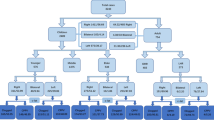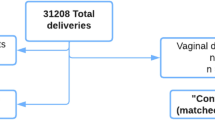Abstract
This case series describes clinical features and management of women who required surgical repair of vaginal injuries following consensual intercourse in our institution during the last decade. As a secondary aim, we reviewed the literature on the topic. We searched our institution’s database for procedures coded as “Suture of Vagina,” excluding trauma not related to consensual sexual activity: between January 2008 and December 2017, 20 women underwent hemostatic suturing for vaginal injuries following intercourse. Mean age was 27.6 ± 12.5 (range, 16–63) years, 5 (25%) women were parous, 13 (65%) women used no contraception, and 1 (5%) used birth control pills. Three patients (15%) were postmenopausal. Eight injuries (40%) occurred following first-time intercourse, two (10%) occurred after intercourse with a new partner. Median time from bleeding onset to admission was 12 (range, 2–24) h. One patient (5%) was hemodynamically unstable and required treatment with packed cells. Median time from admission to surgery was 56 (range, 15–540) min. The laceration site was identified at the vaginal fornix in nine (45%) patients, at mid-vagina in four (20%), at the hymenal ring, or the posterior fourchette in six (30%). Tear of a longitudinal vaginal septum was identified in one patient (5%). To conclude, vaginal postcoital injuries are a rare occurrence, nevertheless they may involve significant blood loss and therefore require prompt evaluation and treatment. Once the patient is hemodynamically stable, psychosexual assessment and support should be offered to the patient and her partner.
This is a preview of subscription content, access via your institution
Access options
Subscribe to this journal
Receive 8 print issues and online access
$259.00 per year
only $32.38 per issue
Buy this article
- Purchase on Springer Link
- Instant access to full article PDF
Prices may be subject to local taxes which are calculated during checkout

Similar content being viewed by others
References
Abasiattai AM, Etuk SJ, Bassey EA, Asuquo EEJ. Vaginal injuries during coitus in Calabar: a 10-year review. Niger Postgrad Med J. 2005;12:140–4.
Omo-Aghoja LO, Ovbagbedia O, Feyi-Waboso P, Okonofua FE. Coitally related traumatic injury of the female genital tract in a Nigerian urban setting: a-5 year review. Niger Postgrad Med J. 2009;16:59–63.
Dao B, Diouf A, Bambara M, Bah MD, Diadhiou F. Vaginal injuries during coitus: 98 cases. Contracept Fertil Sex. 1995;23:420–2.
Jana N, Santra D, Das D, Das AK, Dasgupta S. Nonobstetric lower genital tract injuries in rural India. Int J Gynecol Obstet. 2008;103:26–9.
Jeng C-J, Wang L-R. Vaginal laceration and hemorrhagic shock during consensual sexual intercourse. J Sex Marital Ther. 2007;33:249–53.
Bhagat M. Coital injury presenting in a 13 year old as abdominal pain and vaginal bleeding. Pediatr Emerg Care. 1996;12:354–5.
Hoffman RJ, Ganti S. Vaginal laceration perforation resulting first Coitus. Pediatr Emerg Care. 2001;17:113–4.
Lask S. Perforation of the posterior fornix and pouch of Douglas during coitus. Br Med J. 1948;1:786.
Fletcher H, Bambury I, Williams M. Post-coital posterior fornix perforation with peritonitis and haemoperitoneum. Int J Surg Case Rep. 2013;4:153–5.
Symeonidis N, Ballas K, Micha A, Psarras K, Pavlidis T. Consensual intercourse resulting in an extensive rectovaginal tear: an extremely rare occurrence. J Sex Med. 2015;12:572–5.
Usifo F, Sharma R, MacRae R, Hargreaves C, Swinhoe JR. Posterior vaginal fornix rupture and haemoperitoneum following sexual intercourse. J Obstet Gynaecol. 2006;26:482–3.
Frioux SM, Blinman T, Christian CW. Vaginal lacerations from consensual intercourse in adolescents. Child Abus Negl. 2011;35:69–73.
Wilson KFG. Lower genital tract trauma. Aust NZ J Obstet Gynaecol. 1966;6:291–3.
Wilson F, Swartz DP. Coital injuries of the vagina. Obstet Gynecol. 1972;39:182–4.
Ahnaimugan S, Asuen MI. Coital laceration of the vagina. Aust NZ J Obstet Gynaecol. 1980;20:180–1.
Sau AK, Dhar KK, Dhall GI. Nonobstetrie lower genital tract trauma. Aust NZ J Obstet Gynaecol. 1993;33:433–5.
Fallat ME, Weaver JM, Hertweck SP, Miller FB. Late follow-up and functional outcome after traumatic reproductive tract injuries in women. Am Surg. 1998;64:858–61.
Sloin MM, Karimian M, Ilbeigi P. Nonobstetric lacerations of the vagina. J Am Osteopath Assoc. 2006;106:271–3.
Habek D, Kulaš T. Nonobstetrics vulvovaginal injuries: mechanism and outcome. Arch Gynecol Obstet. 2007;275:93–7.
Inuwa U, Bako B, Mairiga AG, Geidam AD. Coital trauma as seen at the University of Maiduguri Teaching Hospital, Maiduguri. Borno Med J. 2013;10:25–9.
Diddle AW. Rupture of the vaginal vault during coitus. West J Surg Obstet Gynecol. 1948;56:414–6.
McColgin SW, Williams LM, Sorrells TL, Morrison JC. Hemoperitoneum as a result of coital injury without associated vaginal injury. Am J Obstet Gynecol. 1990;163:1503–5.
Howard JM, Diaz MCG, Soler ME. Hemorrhagic shock resulting from post-coital vaginal bleeding in an adolescent with Ehlers-Danlos type IV. Pediatr Emerg Care. 2009;25:397–8.
Tchounzou R, Chichom‐Mefire A. Retrospective analysis of clinical features, treatment and outcome of coital injuries of the female genital tract consecutive to consensual sexual intercourse in the limbe regional hospital. Sex Med. 2015;3:256–60.
Sprecher S, Hatfield E, Cortese A, Potapova E, Levitskaya A. Token resistance to sexual intercourse and consent to unwanted sexual intercourse: college students’ dating experiences in three countries. J Sex Res. 1994;31:125–32.
O’Sullivan LF, Allgeier ER. Feigning sexual desire: consenting to unwanted sexual activity in heterosexual dating relationships. J Sex Res. 1998;35:234–43.
Cuzin B. Anatomy and physiology of female sexual organs. In: The ESSM manual of sexual medicine. Amsterdam: Medix; 2015. p. 40–67.
Alappattu MJ, George SZ, Robinson ME, Fillingim RB, Moawad N, LeBrun EW, et al. Painful intercourse is significantly associated with evoked pain perception and cognitive aspects of pain in women with pelvic pain. Sex Med. 2015;3:14–23.
Reissing E, Brown C, Lord M, Binik Y, Khalifé S. Pelvic floor muscle functioning in women with vulvar vestibulitis syndrome. J Psychosom Obstet Gynecol. 2005;26:107–13.
van der Velde J, Everaerd W. The relationship between involuntary pelvic floor muscle activity, muscle awareness and experienced threat in women with and without vaginismus. Behav Res Ther. 2001;39:395–408.
Van Lunsen RHW, Ramakers M. The hyperactive pelvic floor syndrome (HPFS): psychosomatic and psycho-sexual aspects of hyperactive pelvic floor disorders with co-morbidity of urogynaecological, gastrointestinal and sexual symptomatology. Acta Endosc. 2002;32:275–85.
Both S, van Lunsen R, Weijenborg P, Laan E. A new device for simultaneous measurement of pelvic floor muscle activity and vaginal blood flow: a test in a nonclinical sample. J Sex Med. 2012;9:2888–902.
Laan E, Van Lunsen RHW. Overactive pelvic floor: female sexual functioning. In: Padoa A, Rosenbaum TY, editors. The overactive pelvic floor; Springer International Publishing, Switzerland, 2016. p. 17–30.
Morgan L, Dill A, Welch J. Sexual assault of postmenopausal women: a retrospective review: Sexual assault of postmenopausal women: a retrospective review. BJOG: Int J Obstet Gynaecol. 2011;118:832–43.
Cunningham FG. Williams obstetrics. 22nd ed. New York: McGraw-Hill; 2005.
Author information
Authors and Affiliations
Corresponding author
Ethics declarations
Conflict of interest
The authors declare that they have no conflict of interest.
Ethical approval
Ethical approval for the study was granted by the local Helsinky Committee.
Informed consent
Informed consent was not applicable due to the study’s retrospective design.
Additional information
Publisher’s note Springer Nature remains neutral with regard to jurisdictional claims in published maps and institutional affiliations.
Rights and permissions
About this article
Cite this article
Padoa, A., Glick Fishman, N., Tsviban, A. et al. Vaginal postcoital injuries requiring surgical intervention: a case series and literature review. Int J Impot Res 33, 110–117 (2021). https://doi.org/10.1038/s41443-020-0234-8
Received:
Revised:
Accepted:
Published:
Issue Date:
DOI: https://doi.org/10.1038/s41443-020-0234-8



